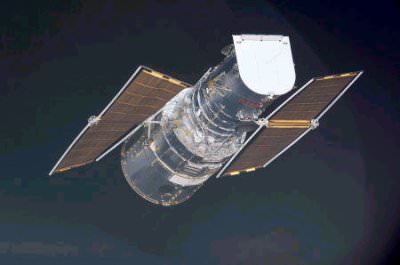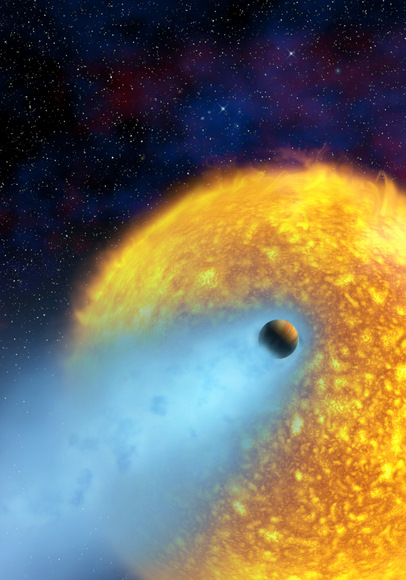It may be a while yet before astronomers agree on a standard model for planet formation around stars. Until recently, after all, Earthlings lacked reliable techniques for glimpsing much beyond our own solar system.
Based on our own backyard, one prevailing theory is that rocky planets like Mercury, Earth and Mars form slowly, close to the sun, from collisions of smaller, solid bodies while gas giants form faster, and farther from the star — often within the first two million years of a star’s life — from smaller rocky cores that readily attract gases.
But new data are suggesting that some gas giants form close to their stars — so close that intense stellar winds rob them of those gases, stripping them back to their cores.
An international research team has found that giant exoplanets orbiting very close to their stars — closer than 2 percent of an Astronomical Unit (AU) — could lose a quarter of their mass during their lifetime. An AU is the distance between the Earth and the Sun.
Such planets may lose their atmospheres completely.
The team, led by Helmut Lammer of the Space Research Institute of the Austrian Academy of Sciences, believes that the recently discovered CoRoT-7b “Super Earth,” which has less than twice the mass of the Earth, could be the stripped core of a Neptune-sized planet.

The team used computer models to study the possible atmospheric mass loss over a stellar lifecycle for exoplanets at orbiting distances of less than 0.06 AU, where the planetary and stellar parameters are very well known from observations.
Mercury is our only neighbor orbiting the Sun in that range; Venus orbits at about .72 AUs.
The 49 planets considered in the study included hot gas giants, planets with masses similar or greater than that of Saturn and Jupiter, and hot ice giants, planets comparable to Uranus or Neptune. All the exoplanets in the sample were discovered using the transit method, where the size and mass of the planet is deduced by observing how much its parent star dims as it the planet passes in front of it.
“If the transit data are accurate, these results have great relevance for planetary formation theories,” said Lammer, who is presenting results at the European Week of Astronomy and Space Science, April 20-23 at the University of Hertfordshire in the UK.
“We found that the Jupiter-type gas giant WASP-12b may have lost around 20-25 percent of its mass over its lifetime, but that other exoplanets in our sample had negligible mass loss. Our model shows also that one major important effect is the balance between the pressure from the electrically charged layer of the planet’s atmosphere and the pressure from the stellar wind and coronal mass ejections (CMEs). At orbits closer than 0.02 AU, the CMEs — violent explosions from the star’s outer layers — overwhelm the exoplanet’s atmospheric pressure causing it to lose maybe several tens of percent of its initial mass during its lifetime.”
The team found that gas giants could evaporate down to their core size if they orbit closer than 0.015 AU. Lower-density ice giants could completely lose their hydrogen envelope at 0.045 AU. Gas giants orbiting at more than 0.02 AU lost about 5-7 percent of their mass. Other exoplanets lost less than 2 percent. Results suggest that CoRoT-7b could be an evaporated Neptune-like planet but not the core of a larger gas giant. Model simulations indicate that larger mass gas giants could not have been evaporated to the mass range determined for CoRoT-7b.
For more information:
The European Week of Astronomy and Space Science
The Royal Astronomical Society


An article on a related topic entitled “The Planetary Air Leak” by David Catling and Kevin Zahnle appears in the May issue of Scientific American. While mainly concerned with changes in planetary atmospheres in our Solar System, extrasolar planets are also discussed and compared with theory and observation (HD209458b). They present an interesting series of graphs looking at parameters like mass, distance from sun, impact effects, etc and what that means for the atmospheres of Solar System planets past, present and future. Even smaller bodies like asteroids or large moons are also discussed. Ties in neatly with this story.
If a planet’s orbit around a star is close enough so that the star’s solar wind strips away a percentage of its mass, wouldn’t that cause the planet’s orbit to expand further out from the star due to the fact that it’s less heavy? If so, then these planets may have been much closer to the star when the system formed…
“If a planet’s orbit around a star is close enough so that the star’s solar wind strips away a percentage of its mass, wouldn’t that cause the planet’s orbit to expand further out from the star due to the fact that it’s less heavy?”
Gravity pulls on all objects equally. As Galileo demonstrated long ago, light objects fall just as fast as heavy ones. (and to be in orbit around an object is to be in a constant ‘fall’ around that object)
IOW, it doesn’t make any difference.
And for most planets (that is, not gas giants), the atmosphere is an insignifigant fraction of its mass, anyway…
Nice 0wnage Frank Glover.
So at the center of the gas giants is a core which could have been a regular planet, had it formed closer to the sun?
That’s interesting, helps me to conceptualize solar system formation; all planets end up initially as gas giants and those closest to the star are stripped of their heavy gas layer and end up as what we would consider “rocky” planets?
@John: Best as I can tell the prevailing thinking is that some planets form as gas giants, while other form as rocky bodies right from the beginning. If you read the article, it says that a Gas Giant has to orbit at 1/50th AU for it to have even a minority chunk of its atmosphere blown away. Mercury is about 4/10th AU. That kind of rules out our inner planets of this solar system having been born as gas giants.
Rocky stars form by magnetically cluttering iron rich lumps spiralling out of the sun (Sun’s huge magnetic fields produce coronal heat and is therefore able to create nuclear fusion; only the heaviest are able to escape and form a protplanetary ring). Mercurius is the youngest planet (2 bilion years) and proof is the big wobbling molten core causing the variation in magnetic field (and elliptical orbit, gravity works only local).
Gas giants are – just like our sun – plasma spheres that form by instantly splitting of a big star in times of starformation. Long time ago they also radiated like the sun and produced rocky planets around them.
To believe this you should let go of the influence of gravity (pull) and big bang theory; think about it.
I dunno, exoplanets all look like a bit of a zoo to me, so ‘m thinking it’s not possible to theorise like these researchers because of the myriad of Start Conditions. There seem to be an infinite variety of stellar nurseries out there, with God knows enough variation even within themselves to produce this dizzying variety in exosystems. Keeps them busy, I suppose.